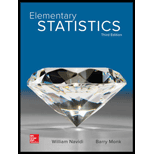
Concept explainers
Success and failure: Three components are randomly sampled, one at a time, from a large lot. As each component is selected, it is tested. If it passes the test, a success (S) occurs; if it fails the test, a failure (F) occurs. Assume that 80% of the components in the lot will succeed passing the test. Let X represent the number of successes among the three sampled components.
What are the possible values for X.
Find P(3).
The
Find P(SFS) and P(SSF).
Use the results of parts (c) and (d) to find P(2).
Find P(l).
Find P(0).
Find
Find
a.
To find:The possible values that the random variable
Answer to Problem 61E
The possible values for
Explanation of Solution
Given:
In the test three components from a lot which has
Calculation:
There are three components in a selected sample.
Out of these three, no successes can be obtained. Hence,
Conclusion:
Therefore, we can identify four possible values for the random variable
b.
To find:The probability to have three successes.
Answer to Problem 61E
The probability
Explanation of Solution
Calculation:
There is
Having three successes
Conclusion:
To have three successes in the test have
c.
To find:The probability that denoted by
Answer to Problem 61E
The probability of the vent
Explanation of Solution
Calculation:
By
Probability of having a success from the lot is given as
Therefore, the probability of
Conclusion:
The probability of the event
d.
To find:The probabilities of the events
Answer to Problem 61E
The probabilities of the events
Explanation of Solution
Calculation:
As calculated in the part (c),
Hence, the probability of the event
Also, the probability of the event
Conclusion:
The probabilities are found to be,
e.
To find:The value of
Answer to Problem 61E
The probability is calculated as,
Explanation of Solution
Calculation:
Occurring two successes is represented by
There are three different ways that two successes such that
Therefore, the probability
Conclusion:
The probability to have two successes is
f.
To calculate:The probability to obtain one success.
Answer to Problem 61E
The probability is found to be,
Explanation of Solution
Calculation:
Within all the possible results of the test, there are only three combinations that have only one success.
Each combination has two failures and one success. Hence, the probability have anyone of these three is equal and it can be calculated as,
The multiplication of these three probabilities and three returns the probability to have one success within the test.
Conclusion:
The probability for obtaining one success is found to be
g.
To find:The probability to not have any successes.
Answer to Problem 61E
The probability is found to be,
Explanation of Solution
Calculation:
To obtain no success, the selected three components should be failures. Hence, there is only one combination for that event.
Selecting three failures from the lot is denoted by
Conclusion:
The probability to have no successes is found to be,
h.
To find:The mean of the number of successes.
Answer to Problem 61E
The mean is found to be,
Explanation of Solution
Calculation:
The probabilities of
w
The mean of the random variable is given by the sum of the values of random variables and the corresponding probabilities.
Conclusion:
The mean of
i.
To find:The standard deviation of the number of successes.
Answer to Problem 61E
The standard deviation is calculated as,
Explanation of Solution
Calculation:
The formula to calculate the variance of a random variable
In the part (h), the mean is calculated as
The sum of right-most column gives the variation of
The standard deviation
Conclusion:
The standard deviation of
Want to see more full solutions like this?
 Calculus For The Life SciencesCalculusISBN:9780321964038Author:GREENWELL, Raymond N., RITCHEY, Nathan P., Lial, Margaret L.Publisher:Pearson Addison Wesley,
Calculus For The Life SciencesCalculusISBN:9780321964038Author:GREENWELL, Raymond N., RITCHEY, Nathan P., Lial, Margaret L.Publisher:Pearson Addison Wesley, Glencoe Algebra 1, Student Edition, 9780079039897...AlgebraISBN:9780079039897Author:CarterPublisher:McGraw Hill
Glencoe Algebra 1, Student Edition, 9780079039897...AlgebraISBN:9780079039897Author:CarterPublisher:McGraw Hill College Algebra (MindTap Course List)AlgebraISBN:9781305652231Author:R. David Gustafson, Jeff HughesPublisher:Cengage Learning
College Algebra (MindTap Course List)AlgebraISBN:9781305652231Author:R. David Gustafson, Jeff HughesPublisher:Cengage Learning Holt Mcdougal Larson Pre-algebra: Student Edition...AlgebraISBN:9780547587776Author:HOLT MCDOUGALPublisher:HOLT MCDOUGALAlgebra & Trigonometry with Analytic GeometryAlgebraISBN:9781133382119Author:SwokowskiPublisher:Cengage
Holt Mcdougal Larson Pre-algebra: Student Edition...AlgebraISBN:9780547587776Author:HOLT MCDOUGALPublisher:HOLT MCDOUGALAlgebra & Trigonometry with Analytic GeometryAlgebraISBN:9781133382119Author:SwokowskiPublisher:Cengage Algebra: Structure And Method, Book 1AlgebraISBN:9780395977224Author:Richard G. Brown, Mary P. Dolciani, Robert H. Sorgenfrey, William L. ColePublisher:McDougal Littell
Algebra: Structure And Method, Book 1AlgebraISBN:9780395977224Author:Richard G. Brown, Mary P. Dolciani, Robert H. Sorgenfrey, William L. ColePublisher:McDougal Littell





